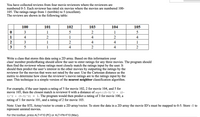
Computer Networking: A Top-Down Approach (7th Edition)
7th Edition
ISBN: 9780133594140
Author: James Kurose, Keith Ross
Publisher: PEARSON
expand_more
expand_more
format_list_bulleted
Question
thumb_up100%
In C++

Transcribed Image Text:You have collected reviews from four movie reviewers where the reviewers are
numbered 0-3. Each reviewer has rated six movies where the movies are numbered 100-
105. The ratings range from 1 (terrible) to 5 (excellent).
The reviews are shown in the following table:
100
101
102
103
104
105
3
1
5
2
1
5
4
2
1
4
4
2
3
1
2
4
4
1
3
5
1
4
2
4
2
Write a class that stores this data using a 2D array. Based on this information your
class' member predictRating should allow the user to enter ratings for any three movies. The program should
then find the reviewer whose ratings most closely match the ratings input by the user. It
should then predict the user's interest in the other movies by outputting the ratings by the
reviewer for the movies that were not rated by the user. Use the Cartesian distance as the
metric to determine how close the reviewer's movie ratings are to the ratings input by the
user. This technique is a simple version of the nearest neighbor classification algorithm.
For example, if the user inputs a rating of 5 for movie 102, 2 for movie 104, and 5 for
movie 105, then the closest match is reviewer 0 with a distance of sqrt((5-5)^2 +
1. The program would then predict a rating of 3 for movie 100, a
(2-
1)^2 + (5-5)^2)
rating of 1 for movie 101, and a rating of 2 for movie 103.
Note: User the STL Array/vector to create a 2D array/vector. To store the data in a 2D array the movie ID's must be mapped to 0-5. Store -1 to
represent unrated movies.
For the toolbar, press ALT+F10 (PC) or ALT+FN+F10 (Mac).
Expert Solution
This question has been solved!
Explore an expertly crafted, step-by-step solution for a thorough understanding of key concepts.
This is a popular solution
Trending nowThis is a popular solution!
Step by stepSolved in 3 steps with 1 images

Knowledge Booster
Recommended textbooks for you
 Computer Networking: A Top-Down Approach (7th Edi...Computer EngineeringISBN:9780133594140Author:James Kurose, Keith RossPublisher:PEARSON
Computer Networking: A Top-Down Approach (7th Edi...Computer EngineeringISBN:9780133594140Author:James Kurose, Keith RossPublisher:PEARSON Computer Organization and Design MIPS Edition, Fi...Computer EngineeringISBN:9780124077263Author:David A. Patterson, John L. HennessyPublisher:Elsevier Science
Computer Organization and Design MIPS Edition, Fi...Computer EngineeringISBN:9780124077263Author:David A. Patterson, John L. HennessyPublisher:Elsevier Science Network+ Guide to Networks (MindTap Course List)Computer EngineeringISBN:9781337569330Author:Jill West, Tamara Dean, Jean AndrewsPublisher:Cengage Learning
Network+ Guide to Networks (MindTap Course List)Computer EngineeringISBN:9781337569330Author:Jill West, Tamara Dean, Jean AndrewsPublisher:Cengage Learning Concepts of Database ManagementComputer EngineeringISBN:9781337093422Author:Joy L. Starks, Philip J. Pratt, Mary Z. LastPublisher:Cengage Learning
Concepts of Database ManagementComputer EngineeringISBN:9781337093422Author:Joy L. Starks, Philip J. Pratt, Mary Z. LastPublisher:Cengage Learning Prelude to ProgrammingComputer EngineeringISBN:9780133750423Author:VENIT, StewartPublisher:Pearson Education
Prelude to ProgrammingComputer EngineeringISBN:9780133750423Author:VENIT, StewartPublisher:Pearson Education Sc Business Data Communications and Networking, T...Computer EngineeringISBN:9781119368830Author:FITZGERALDPublisher:WILEY
Sc Business Data Communications and Networking, T...Computer EngineeringISBN:9781119368830Author:FITZGERALDPublisher:WILEY

Computer Networking: A Top-Down Approach (7th Edi...
Computer Engineering
ISBN:9780133594140
Author:James Kurose, Keith Ross
Publisher:PEARSON

Computer Organization and Design MIPS Edition, Fi...
Computer Engineering
ISBN:9780124077263
Author:David A. Patterson, John L. Hennessy
Publisher:Elsevier Science

Network+ Guide to Networks (MindTap Course List)
Computer Engineering
ISBN:9781337569330
Author:Jill West, Tamara Dean, Jean Andrews
Publisher:Cengage Learning

Concepts of Database Management
Computer Engineering
ISBN:9781337093422
Author:Joy L. Starks, Philip J. Pratt, Mary Z. Last
Publisher:Cengage Learning

Prelude to Programming
Computer Engineering
ISBN:9780133750423
Author:VENIT, Stewart
Publisher:Pearson Education

Sc Business Data Communications and Networking, T...
Computer Engineering
ISBN:9781119368830
Author:FITZGERALD
Publisher:WILEY